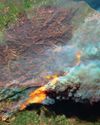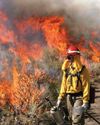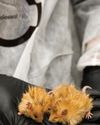Intentar ORO - Gratis
Going Off the (Really) Deep End
Muse Science Magazine for Kids
|July/August 2023
DIVING INTO THE DEEPEST PLACE ON EARTH, CHALLENGER DEEP IN THE MARIANA TRENCH

Help Wanted: Expedition seeks explorers brave enough to face bizarre, glow-in-the-dark creatures. Must be able to navigate safely past vents spewing liquid carbon dioxide, erupting mud volcanoes, and a treacherous lake of molten sulfur.
What strange corner of the universe is this expedition headed for? It's a cozy little planet known as Earth and a spot miles under the surface of the Pacific Ocean called the Mariana Trench.

A Hole in the Ocean Floor
In 1872, the HMS Challenger expedition set out to map the ocean floor. The explorers spent four years crisscrossing the globe, sailing 70,000 miles (112,654 kilometers)-one-third of the distance to the Moon. It was backbreaking, boring work. Sail about 200 miles (322 kilometers), drop a weighted rope into the water. Measure how much rope it took to hit bottom. Sail another 200 miles and do it again. And again. This expedition was a total snooze fest, until a day in 1875 about 200 miles (322 kilometers) off the coast of Guam. That morning, when the to pe was dropped, the ocean swallowed up five miles (eight kilometers) of it. The Challenger's crew had discovered a "hole" in the ocean floor.

Braving the Depths
Esta historia es de la edición July/August 2023 de Muse Science Magazine for Kids.
Suscríbete a Magzter GOLD para acceder a miles de historias premium seleccionadas y a más de 9000 revistas y periódicos.
¿Ya eres suscriptor? Iniciar sesión
MÁS HISTORIAS DE Muse Science Magazine for Kids

Muse Science Magazine for Kids
ANIMAL FIREFIGHTER TO THE RESCUE
Can animals help manage the risks of deadly wildfires?
3 mins
Muse July 2025: The Story Behind Wildfires

Muse Science Magazine for Kids
FIRE DANGER
WHY THE RISK OF WILDFIRES KEEPS GROWING
4 mins
Muse July 2025: The Story Behind Wildfires

Muse Science Magazine for Kids
The Miller NEW Normal
WHAT TODAY’S WILDFIRES TELL US ABOUT OUR FUTURE
8 mins
Muse July 2025: The Story Behind Wildfires

Muse Science Magazine for Kids
WOMEN AND FIREFIGHTING: A GOOD FIT
Jessica Gardetto is a firefighter. Her father was, too. “I grew up with my dad coming home smelling like wildfire and covered in soot,” she says.
1 min
Muse July 2025: The Story Behind Wildfires

Muse Science Magazine for Kids
What is happening on your fingertips when they get all wrinkly in a hot tub?
—Felix G., age 10, Montana
1 mins
Muse July 2025: The Story Behind Wildfires

Muse Science Magazine for Kids
WHEN the SMOKE CLEARS
THE LINGERING EFFECTS OF THE RECENT PACIFIC PALISADES AND ALTADENA EATON FIRES
6 mins
Muse July 2025: The Story Behind Wildfires

Muse Science Magazine for Kids
PICKING TEAMS
Keep it fair with a strategy that relies on geometry.
2 mins
Muse July 2025: The Story Behind Wildfires

Muse Science Magazine for Kids
SHAN CAMMACK
WILDLIFE BIOLOGIST AND FIRE SAFETY OFFICER
3 mins
Muse July 2025: The Story Behind Wildfires

Muse Science Magazine for Kids
Scientists Create Mice With Woolly Mammoth-Like Fur
RESEARCHERS AT A COMPANY IN TEXAS ARE WORKING TO CREATE A LIVING ANIMAL THAT RESEMBLES THE EXTINCT WOOLLY MAMMOTH. Recently, they produced mice with traits of the large mammal. The mice all have coats with mammoth-like fur, and some of the small mammals also have genes that help them store fat. Both features would help the animals survive in the cold Arctic, where the woolly mammoth once lived.
1 min
Muse July 2025: The Story Behind Wildfires

Muse Science Magazine for Kids
Cool Sunshade Added to the Nancy Roman Space Telescope
THE NANCY ROMAN SPACE TELESCOPE IS A NEW TELESCOPE THAT NASA IS BUILDING AND WILL LAUNCH INTO SPACE, LIKELY IN EARLY 2027.
1 min
Muse July 2025: The Story Behind Wildfires
Translate
Change font size

